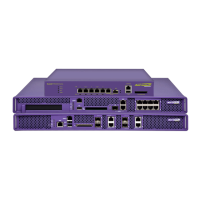Summit WM3000 Series Controller System Reference Guide 27
DHCP User Class Options
A DHCP Server groups clients based on defined user-class option values. Clients with a defined set of
user-class values are segregated by class. The DHCP Server can associate multiple classes to each pool.
Each class in a pool is assigned an exclusive range of IP addresses.
DHCP clients are compared against classes. If the client matches one of the classes assigned to the pool,
it receives an IP address from the range assigned to the class. If the client doesn't match any of the
classes in the pool, it receives an IP address from a default pool range (if defined).
Multiple IP addresses for a single VLAN allow the configuration of multiple IP addresses, each
belonging to different subnet. Class configuration allows a DHCP client to obtain an address from the
first pool to which the class is assigned. For more information, see “Configuring the DHCP User Class”
on page 253.
DDNS
Dynamic DNS (DDNS) keeps a domain name linked to a changing IP address. Typically, when a user
connects to a network, the user is assigned an unused IP address from a pool of IP addresses. This
address may only be valid for a short period. Dynamically assigning IP addresses increases the pool of
assignable IP addresses. DNS maintains a database to map a given name to an IP address used for
communication on the Internet. The dynamic assignment of IP addresses makes it necessary to update
the DNS database to reflect the current IP address for a given name. Dynamic DNS updates the DNS
database to reflect the correct mapping of a given name to an IP address.
VLAN Enhancements
The controller has incorporated the following VLAN enhancements:
● Network interfaces operate in either trunk or access modes.
● A network interface in access mode can only send and receive untagged packets.
● A trunk port can now receive both tagged and untagged packets. Each ethernet port is assigned a
native VLAN.
● You can now configure a set of allowed VLANs on a trunk port. Packets received on this port that
belong to other VLANs are discarded.
Interface Management
The controller’s physical interfaces auto-negotiate speed and duplex. The controller also allows:
● Manual bandwidth configuration of a physical interface speed to 10/100/1000Mbps.
● Manual duplex configuration of a physical interface to Full Duplex or Half Duplex.
● Manual configuration of administrative shutdown of a physical interface.
Management Features
The controller supports the following management features:
● A secure, browser-based management console
● A Command Line Interface (CLI) accessible via the serial port or through Telnet or a Secure Shell (SSH)
application

